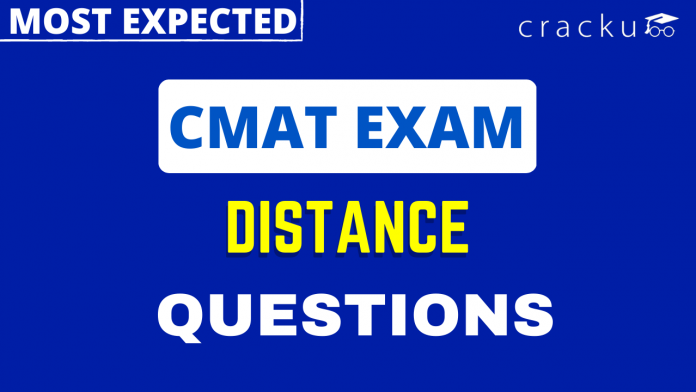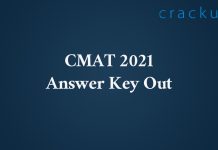CMAT 2023 Distance Important Questions [PDF]
Distance is one of the most important topics in the CMAT, and also it is an important section. One can utilize this article which consists of the most important questions regarding Distance. Cracku provides you with the Top 20 very Important Distance Questions for CMAT based on the questions asked in previous exam papers. Click on the link below to download the Distance Questions for CMAT PDF with detailed answers.
Download Distance Questions for CMAT
Enroll to CMAT 2023 Crash Course
Question 1: A train covers 450 km at a uniform speed. If the speed had been 5 km/h more, it would have taken 1 hour less to cover the same distance. How much time will it take to cover 315 km at its usual speed?
a) 7h 52m
b) 6h 30m
c) 6h 18m
d) 7h
1) Answer (D)
Solution:
Let the uniform speed of train = s
According to the problem,
$\frac{450}{s+5}=\frac{450}{s}-1$
$\frac{450}{s}-\frac{450}{s+5}=1$
$450\left(\frac{s+5-s}{s\left(s+5\right)}\right)=1$
$450\left(\frac{5}{s^2+5s}\right)=1$
$s^2+5s-2250=0$
$\left(s+50\right)\left(s-45\right)=0$
s = -50 or s = 45
s cannot be negative, so s = 45 km/h
The uniform speed of train = 45 km/h
Time taken by train to cover 315 km at its usual speed = $\frac{315}{45}$ = 7 hours
Hence, the correct answer is Option D
Question 2: A car can cover a distance of 144 km in 1.8 hours. In what time(in hours) will it cover double the distance when its speed is increased by 20% ?
a) 3
b) 2.5
c) 2
d) 3.2
2) Answer (A)
Solution:
Speed of the car = $\frac{144}{1.8}$ = 80 km/hr
Speed of the car when increased by 20% = $\frac{120}{100}\times$80 = 96 km/hr
Required time = $\frac{288}{96}$
= 3 hours
Hence, the correct answer is Option A
Question 3: The speed of a train is 220% of the speed of a car. The car covers a distance of 950 km in 19 hours. How much distance will the train cover in $3 \frac{1}{2}$ hours?
a) 380 km
b) 385 km
c) 375 km
d) 285 km
3) Answer (B)
Solution:
Speed of the car = $\frac{950}{19}$ = 50 km/h
Given, speed of the train is 220% of the speed of the car
$\Rightarrow$ Speed of the train = $\frac{220}{100}\times50$ = 110 km/h
$\therefore\ $Distance covered by the train in $3 \frac{1}{2}$ hours = $110\times3\frac{1}{2}$ = $110\times\frac{7}{2}$ = 385 km
Hence, the correct answer is Option B
Question 4: A car covered 150 km in 5 hours. If it travels at one-third its usual speed, then how much more time will it take to cover the same distance?
a) 12 hours
b) 14 hours
c) 10 hours
d) 8 hours
4) Answer (C)
Solution:
Given, the car covered 150 km in 5 hours
Speed of the car = $\frac{150}{5}$ = 30 km/h
One third of the speed = $\frac{1}{3}\times30$ = 10 km/h
Time required for the car to cover 150 km with one third speed = $\frac{\text{Distance}\\ }{\text{Speed}}$ = $\frac{150}{10}$ = 15 hours
$\therefore\ $Extra time required to cover the distance with one third speed = 15 – 5 = 10 hours
Hence, the correct answer is Option C
Question 5: Rahul and Mithun travel a distance of 30 km. The sum of their speeds is 70 km/h and the total time taken by both to travel the distance is 2 hours 6 minutes. The difference between their speeds is:
a) 35 km/h
b) 20 km/h
c) 25 km/h
d) 30 km/h
5) Answer (D)
Solution:
Let the speed of Rahul = s
$\Rightarrow$ Speed of Mithun = 70 – s
Time taken by Rahul to cover 30 km distance = $\frac{30}{s}$
Time taken by Mithun to cover 30 km distance = $\frac{30}{70-s}$
Given, total time = 2 hours 6 minutes = 2 + $\frac{6}{60}$ hours = 2 + $\frac{1}{10}$ hours = $\frac{21}{10}$ hours
$\Rightarrow$ $\frac{30}{s}+\frac{30}{70-s}=\frac{21}{10}$
$\Rightarrow$ $\frac{1}{s}+\frac{1}{70-s}=\frac{7}{100}$
$\Rightarrow$ $\frac{70-s+s}{s\left(70-s\right)}=\frac{7}{100}$
$\Rightarrow$ $\frac{70}{70s-s^2}=\frac{7}{100}$
$\Rightarrow$ $70s-s^2=1000$
$\Rightarrow$ $s^2-70s+1000=0$
$\Rightarrow$ $s^2-50s-20s+1000=0$
$\Rightarrow$ $s\left(s-50\right)-20\left(s-50\right)=0$
$\Rightarrow$ $\left(s-50\right)\left(s-20\right)=0$
$\Rightarrow$ $s-50=0$ or $s-20=0$
$\Rightarrow$ s = 50 km/h or s = 20 km/h
When speed of Rahul = 50 km/h, speed of mithun = 20 km/h
When speed of Rahul = 20 km/h, speed of mithun = 50 km/h
$\therefore\ $Difference between their speeds = 30 km/h
Hence, the correct answer is Option D
Question 6: Mohan travels three equal distances at speeds of 12 km/h, 18 km/h and 24 km/h.If he takes a total of 13 hours, then what is the total distance covered?
a) 214 km
b) 212 km
c) 216 km
d) 218 km
6) Answer (C)
Solution:
Let the total distance be 3d
Time taken to cover the distance at speed 12 km/h = $\frac{d}{12}$ hour
Time taken to cover the distance at speed 18 km/h = $\frac{d}{18}$ hour
Time taken to cover the distance at speed 24 km/h = $\frac{d}{24}$ hour
Given, total time = 13 hours
$\Rightarrow$ $\frac{d}{12}+\frac{d}{18}+\frac{d}{24}=13$
$\Rightarrow$ $\frac{6d+4d+3d}{72}=13$
$\Rightarrow$ $\frac{13d}{72}=13$
$\Rightarrow$ d = 72 km
$\therefore\ $Total distance = 3d = 3 x 72 = 216 km
Hence, the correct answer is Option C
Question 7: The diameter of a wheel is 49 cm. The number of revolutions in which it will have to cover a distance of 770 m, is:
a) 400
b) 500
c) 700
d) 600
7) Answer (B)
Solution:
Given, diameter of the wheel = 49 cm
Perimeter of the wheel = 49$\pi =49\times\frac{22}{7}=154$cm
Distance to be covered = 770 m = 770$\times$100 cm
$\therefore\ $The number of revolutions in which it will have to cover a distance of 770 m = $\frac{770\times100}{154}=500$
Hence, the correct answer is Option B
Question 8: Mohan finishes a journey by scooter in 5 hours. He travels the first half of the journey at 30 km/h and the second half of the journey at 20 km/h. The distance covered by him is:
a) 130 km
b) 120 km
c) 140 km
d) 100 km
8) Answer (B)
Solution:
Let the total distance covered by Mohan = d
Time taken by Mohan to cover the first half = $\frac{\frac{d}{2}}{30}$ = $\frac{d}{60}$ hours
Time taken by Mohan to cover the second half = $\frac{\frac{d}{2}}{20}$ = $\frac{d}{40}$ hours
Total time for the journey = 5 hours
$\Rightarrow$ $\frac{d}{60}+\frac{d}{40}=5$
$\Rightarrow$ $\frac{2d+3d}{120}=5$
$\Rightarrow$ $\frac{5d}{120}=5$
$\Rightarrow$ d = 120 km
$\therefore\ $Distance covered by Mohan = 120 km
Hence, the correct answer is Option B
Question 9: A man travelled a distance of 35 km in 5 hours. He travelled partly on foot at the rate of 4 km/h and the rest on bicycle at the rate of 9 km/h. The distance travelled on foot is:
a) 8 km
b) 10 km
c) 15 km
d) 12 km
9) Answer (A)
Solution:
Let the distance travelled on foot = d
$\Rightarrow$ Distance travelled on bicycle = 35 – d
Speed of the man on foot = 4 km/h
Time taken by the man on foot = $\frac{d}{4}$
Speed of the man on bicycle = 9 km/h
Time taken by the man on bicycle = $\frac{35-d}{9}$
Total time taken by the man = 5 hours
$\Rightarrow$ $\frac{d}{4}+\frac{35-d}{9}=5$
$\Rightarrow$ $\frac{d}{4}+\frac{35}{9}-\frac{d}{9}=5$
$\Rightarrow$ $\frac{9d-4d}{36}=5-\frac{35}{9}$
$\Rightarrow$ $\frac{5d}{36}=\frac{10}{9}$
$\Rightarrow$ d = 8 km
$\therefore\ $Distance travelled on foot = 8 km
Hence, the correct answer is Option A
Question 10: A person covers 700 m distance in 6 minutes. What is his speed in km/h?
a) 3.45 km/h
b) 7 km/h
c) 6 km/h
d) 6.23 km/h
10) Answer (B)
Solution:
Given,
Distance = 700 m = $\frac{700}{1000}$ km
Time = 6 minutes = $\frac{6}{60}$ hr
Speed = $\frac{\text{Distance}}{\text{Time}}$ = $\frac{\frac{700}{1000}}{\frac{6}{60}}$ = $\frac{700}{1000}\times\frac{60}{6}$ = 7 km/h
Hence, the correct answer is Option B
Question 11: Two cars start from the same place at the same time at right angles to each other. Their speeds are 54 km/hr and 72 km/hr, respectively. After 20 seconds the distance between them will be:
a) 720 m
b) 480 m
c) 500 m
d) 540 m
11) Answer (C)
Solution:
Let the cars start at a point A
Speed of first car = 54 km/hr = $54\times\frac{5}{18}$ m/s = 15 m/s
Distance travelled by first car in 20 seconds = $15\times20$ = 300 m
Speed of second car = 72 km/hr = $72\times\frac{5}{18}$ = 20 m/s
Distance travelled by second car in 20 seconds = $20\times20$ = 400 m

Two cars move at right angle to each other
Let the position of the cars are B and C after 20 seconds respectively as shown in figure
From the figure,
$AC^2+AB^2=BC^2$
$=$> $400^2+300^2=BC^2$
$=$> $1600+900=BC^2$
$=$> $BC^2=2500$
$=$> $BC=500$ m
$\therefore\ $Distance between the cars after 20 seconds = BC = 500 m
Hence, the correct answer is Option C
Question 12: A person walks a distance from point A to B at 15 km/h, and from point B to A at 30 km/h. If he takes 3 hours to complete the journey, then what is the distance from point A to B?
a) 15 km
b) 30 km
c) 25 km
d) 10 km
12) Answer (B)
Solution:
Let the distance between point A and B = ‘d’ km
Speed of the person from point A to B = 15 km/h
Time taken by the person to walk from point A to B = $\frac{d}{15}$ hours
Speed of the person from point B to A = 30 km/h
Time taken by the person to walk from point B to A = $\frac{d}{30}$ hours
Total time taken to complete the journey = 3 hours
$=$> $\frac{d}{15}+\frac{d}{30}=3$
$=$> $\frac{2d+d}{30}=3$
$=$> $\frac{3d}{30}=3$
$=$> $d=30$ km
$\therefore\ $Distance from point A to B = 30 km
Hence, the correct answer is Option B
Question 13: The distance covered by a train in $(x + 1)$ hours is $( x^3 + 1)$ km. What is the speed of the train?
a) $(x+ 1)$ km/h
b) $(x^2 + x + 1) km/h$
c) $(x^2 – x + 1) km/h$
d) $(x^3 – 1) km/h$
13) Answer (C)
Solution:
Given,
Distance covered by the train = $( x^3 + 1)$ km
Time taken by the train = $(x+1)$ hours
Speed of the train = $\frac{\text{Distance covered}}{\text{Time taken}}$
$=\frac{\left(x^3+1\right)}{\left(x+1\right)}$
$=\frac{\left(x+1\right)\left(x^2-x+1\right)}{\left(x+1\right)}$
$=\left(x^2-x+1\right) km/h$
Hence, the correct answer is Option C
Question 14: Mohan covers a distance of 2.5 km by scooter at the rate of 30 km/h. The time taken by Mohan to cover the given distance in minutes is:
a) 10
b) 6
c) 8
d) 5
14) Answer (D)
Solution:
Given,
Distance travelled = 2.5 km
Speed = 30 km/hr
$\text{Time taken}=\ \frac{\text{Distance travelled}}{\text{Speed}}=\frac{2.5}{30}hr=\frac{25}{30\times10}hr=\frac{25}{30\times10}\times60\min=5\min$
Hence, The correct answer is Option D
Question 15: An athlete crosses a distance of 900 m in 10 minutes. What is his speed in km per hour?
a) 5.4 km/h
b) 6.9 km/h
c) 3.6 km/h
d) 4.8 km/h
15) Answer (A)
Solution:
Given, Distance = 900 m
Time = 10 min = 10 x 60 sec = 600 sec
Speed = $\ \frac{\text{Distance}}{\text{Time}} $ = $=\frac{900}{600}=\frac{3}{2}$ m/sec = $\frac{3}{2}\times\frac{18}{5}$ km/h = $\frac{27}{5}$ km/h = 5.4 km/h
Hence, the correct answer is Option A
Question 16: A train travels the distance between stations P and Q at a speed of 126 km/h, while in the opposite direction it comes back at 90 km/h. Another train travels the same distance at the average speed of the first train. The time taken by the second train to travel 525 km is:
a) 4 hours 20 min
b) 5 hours 20 min
c) 5 hours
d) 4 hours
16) Answer (C)
Solution:
Let the distance between stations P and Q = d
Time taken by the first train to travel from P to Q = $\frac{d}{126}$
Time taken by the first train to travel from Q to P = $\frac{d}{90}$
Average speed of the first train = $=\frac{\text{Total distance}}{\text{Total time}}=\frac{2d}{\frac{d}{126}+\frac{d}{90}}=\frac{2\times126\times90}{126+90}=\frac{2\times126\times90}{216}$ = 105 km/h
Given, Average speed of the second train is same as that of first train
$=$> Average speed of the second train = 105 km/h
$\therefore\ $The time taken by the second train to travel 525 km = $\frac{525}{105}$ = 5 hours
Hence, the correct answer is Option C
Question 17: The distance between the places H and O is D units. The average speed that gets a person from H to O in a stipulated time is S units. He takes 20 minutes more time than usual if he travels at 60 km/h, and reaches 44 minutes early if he travels at 75 km/h. The sum of the numerical values of D and S is:
a) 376
b) 358
c) 344
d) 384
17) Answer (D)
Solution:
Distance between places H and O = D units
Average speed of the person from H to O = S
He takes 20 minutes more time than usual if he travels at 60 km/h
$=$> $\frac{D}{60}-\frac{D}{S}=\frac{20}{60}$ ………….(1)
He reches 44 minutes early than usual if he travels at 75 km/h
$=$> $\frac{D}{S}-\frac{D}{75}=\frac{44}{60}$ …………..(2)
Solving (1)+(2)
$\frac{D}{60}-\frac{D}{75}=\frac{20}{60}+\frac{44}{60}$
$=$> $\frac{15D}{60\times75}=\frac{64}{60}$
$=$> D = 320
From (1), $\frac{320}{60}-\frac{320}{S}=\frac{20}{60}$
$=$> $\frac{16}{60}-\frac{16}{S}=\frac{1}{60}$
$=$> $\frac{16}{S}=\frac{16}{60}-\frac{1}{60}$
$=$> $\frac{16}{S}=\frac{15}{60}$
$=$> S = 64
$\therefore\ $Sum of D and S = 320 + 64 = 384
Hence, the correct answer is Option D
Question 18: The distance between two railway stations is 1176 km. To cover this distance, an express train takes 5 hours less than a passenger train while the average speed of the passenger train is 70 km/h less than that of the express train. The time taken by the passenger train to complete the travel is:
a) 12 hours
b) 23 hours
c) 17 hours
d) 18 hours
18) Answer (A)
Solution:
Given,
Distance between two railway stations = 1176 km
Let the time taken by passenger train to cover the distance = t
$=$> Time taken by express train to cover the distance = t – 5
The average speed of the passenger train is 70 km/h less than that of the express train
$=$> $\frac{1176}{t-5}-\frac{1176}{t}=70$
$=$> $\frac{168}{t-5}-\frac{168}{t}=10$
$=$> $168\left[\frac{t-t+5}{\left(t-5\right)t}\right]=10$
$=$> $168\left[\frac{5}{\left(t-5\right)t}\right]=10$
$=$> $t^2-5t-84=0$
$=$> $t^2-12t+7t-84=0$
$=$> $t\left(t-12\right)+7\left(t-12\right)=0$
$=$> $\left(t-12\right)\left(t+7\right)=0$
$=$> $t-12=0$ or $t+7=0$
$=$> $t=12$ or $t=-7$
t cannot be negative
$=$> $t=12$
$\therefore\ $The time taken by the passenger train to complete the travel = 12 hours
Hence, the correct answer is Option A
Question 19: The time taken by a boat to travel 13 km downstream is the same as time taken by it to travel 7 km upstream. If the speed of the stream is 3 km/h, then how much time (in hours) will it take to travel a distance of 44.8 km in still water?
a) $4\frac{12}{25}$
b) $5\frac{3}{5}$
c) $5\frac{2}{5}$
d) $4\frac{13}{25}$
19) Answer (A)
Solution:
Speed of the stream = 3 km/h
Let the speed of the boat be v.
Speed in downstream = 3 + v
Speed in upstream = v – 3
Time = distance/speed
According to the question,
The time taken by a boat to travel 13 km downstream = time taken by boat to travel 7 km upstream
13/(3 + v) = 7/(v – 3)
13v – 39 = 21 + 7v
6v = 60
v = 10 km/h
Speed of boat = 10 km/h
The time taken by a boat to travel a distance of 44.8 km in still water = 44.8/10 = 112/25 = $ 4 \frac{12}{25}$ hr
Question 20: The distance between two stations A and B is 575 km. A train starts from station ‘A’ at 3:00 p.m. and moves towards station ‘B’ at an average speed of 50 km/h. Another train starts from station ‘B’ at 3:30 p.m. and moves towards station ‘A’ at an average speed of 60 km/h. How far from station ‘A’ will the trains meet ?
a) 275 km
b) 325 km
c) 300 km
d) 225 km
20) Answer (A)
Solution:
Distance between stations = 575 km
Speed of train A = 50 km/hr
Distance covered by train A in (30 min = 1/2 hr) = time $\times speed = 50 \times 1/2 = 25 km$
Trains are running in opposite direction so,
Relative speed = 50 + 60 = 110 km/hr
Distance covered by both train = 575 – 25 = 550 km
Time taken by both trains to meet = 550/110 = 5 hr
Distance covered by train A in 5 hr = 5 $\times 50 = 250 km$
Distance covered by train A from station A = distance covered by train A in 30 min + distance covered by train A in 5 = 250 + 25 = 275 km
$\therefore$275 km far from station ‘A’ will the trains meet.





